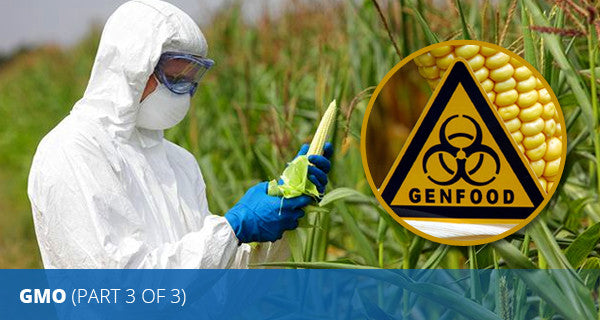In part two of the GMO series, we discussed how GM foods can cause unknown and unpredictable changes in the body – and may lead to mutations, formation of new proteins, allergies and disease. Another obvious risk comes from the increased use of pesticides to restrain super weeds – implicated not only in impacting our health but also disturbing the fragile balance within the eco-system [1]. In this third and final part in our GMO series, let’s discuss how we can avoid landing into the GMO trap.
Solid long-term safety studies are lacking. The USA FDA has no control over how these studies are conducted, and evaluated. There is an increasing paranoia about the safety and consumption of foods that contain genetically modified organisms. On a positive note, people are becoming aware of associated health and environmental risks. A total of 64 countries around the world require GMO labelling [2] and in countries that don’t, people are pushing for labelling laws.
As a consumer, how can you protect yourself? How about entirely banning GM foods from your life?
But first, be well-informed
Information is one of the biggest tools in your battle against GMOs. You must know what crops are genetically modified, what ingredients are made using GM crops, what goes into the animal feed and what are the surprising, hidden sources of genetically modified foods. Here is some help.
Common culprits and beyond
Cotton, canola, corn, soybean and sugar beets are the common culprits but not the only ones. Almost all processed foods have at least one ingredient, if not more, that is derived from the main GM crops we just mentioned.
The Center for Food Safety says, “Currently, up to 92% of U.S. corn is genetically engineered (GE), as are 94% of soybeans and 94% of cotton (cottonseed oil is often used in food products). It has been estimated that upwards of 75% of processed foods on supermarket shelves – from soda to soup, crackers to condiments – contain genetically engineered ingredients.”
So, the quickest way to say goodbye to GMOs would be to stop using processed food products. It shouldn’t be tough. There is already a motivation factor; processed foods are devoid of any real nutrition but are chock-a-full of artificial flavours, artificial colours and preservatives – compromising our health in a number of ways.
High risk vs low risk GM foods?
Corn, soy, alfalfa, cotton, canola, papaya, sugar beet, zucchini/yellow summer squash, dairy products, and honey are all high-risk GMO foods [3]. But it is important to know that even some ingredients considered low risk can be risky. For example, dried raisins and prunes can be coated with oil, though in a miniscule amount. Chances are that this oil is produced from genetically modified soybeans or canola.
GMO food in animal feed
If you eat meat or enjoy dairy products, GMOs reach you through a different route. No points for guessing what cows, pigs, fish and chickens are eating. Maize, soya, corn and cotton seeds are the main source of animal feed around the world. According to the Non-GMO Project, “Animal products such as milk, meat, eggs, and honey are considered high-risk inputs due the prevalence of GMOs in animal feed.”
You will be surprised to know that your supplements and skincare products may also contain GMOs. Where else you may come face to face with GMOs?
For a comprehensive list of GM crops and high risk crops, check GMOs in Food (Institute for Responsible Technology), Avoid List (GMO Awareness), and 5 Surprising Genetically Modified Foods (Mother Jones.)
How can you avoid GM Foods?
- First and foremost, say no to processed foods.
- Buy food that is 100% organically grown.
- You can also grow your own produce or look out for local farmers
- Go for products that carry Non-GMO Project verification
- Look for a USDA Certified Organic label.
When you clamour for change……
We may not bring desired change in the labelling laws soon, but as consumers, we have amazing powers. All we need to do is step up and say no to GMO foods, and it is bound to hit the bottom lines of the food companies. Whether out of believing in the anti-GMO movement or out of fear of losing their customer base, many companies have shown serious efforts in removing GMOs from their product lines.
Chipotle, General Mills, Whole Foods Market, Del Monte, Dannon and Nestle are some giants that have bowed down to the customer’s clear preference [4]. Many other companies are joining the movement too and are in the process of phasing out GMOs, artificial flavourings, fake colors and preservatives from their products.
References:
- John Fagan, Michael Antoniou, Claire Robinson. GMO Myths and Truths. Earth Open Source.
- Labeling Around the World. Just Label It.
- Which foods might contain GMOs? Living Non-GMO.
- Ken Roseboro. More major food companies switch to non-GMO ingredients. The Organic & Non-GMO Report. 2016.
Disclaimer
Information on our websites, in our blogs and our emails are provided for informational purposes only, and have not been evaluated by the EMA, EFSA or FDA. It is not meant to substitute medical advice provided by your healthcare professional and is not intended to diagnose, treat, cure, or prevent any disease. Our products are intended for adults, 18 years of age and older. While the vitamins and supplements mentioned here have been shown to have various health benefits, it is important to remember that supplements and dietary changes should be considered as part of an overall health plan and not as a substitute for professional medical treatment. Only a qualified healthcare practitioner can provide personalized advice and treatment plans based on your individual health needs and medical history, and you should seek advice from your healthcare professional before taking product(s) if you are pregnant or nursing.

